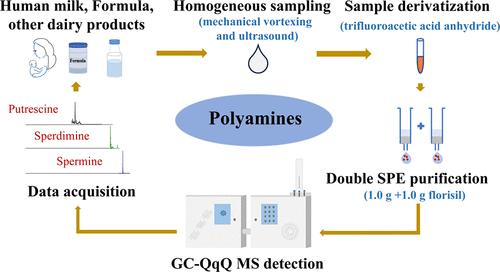Identification of Polyamines in Human Milk, Formula Milk, and Other Dairy Products: a Special Method Based on Precolumn Derivatization, Double-Florisil Purification, and Gas Chromatography–Triple Quadrupole Mass Spectrometry
IF 6.2
1区 农林科学
Q1 AGRICULTURE, MULTIDISCIPLINARY
引用次数: 0
Abstract
Polyamines in human milk are essential for the rapid growth and development of neonates and infants. However, the concentrations of polyamines in human milk have not been well characterized and the special methods for detecting polyamines in human milk, formula milk, or other dairy products remain largely unavailable to date. In this study, an accurate and sensitive method based on trifluoroacetic acid anhydride (TFAA) derivatization, double solid-phase extraction (SPE) purification, and gas chromatography–triple quadrupole mass spectrometry (GC-QqQ MS) was established for the evaluation of polyamines in human milk, formula milk, and other dairy products. High coefficients of determination for internal calibration curves were obtained (R2 > 0.99). Low limits of detection (5.0, 1.0, and 0.5 nmol/dL) and limits of quantification (10.0, 3.0, and 1.0 nmol/dL) for putrescine, spermidine, and spermine, respectively, were also achieved. The precision (expressed as relative standard deviation, RSD < 9.0%) and recovery rates (78.3–108.4%) were satisfactory. Spermidine and spermine in human milk were found significantly higher than those in formula milk and commercial cow’s milk. The difference of polyamine content in human milk and infant formula should be paid attention to, particularly when infant formula is used as a complete replacement for human milk.

鉴定母乳、配方奶和其他乳制品中的多胺:一种基于柱前衍生化、双花硅净化和气相色谱-三重四极杆质谱法的特殊方法
母乳中的多胺对新生儿和婴儿的快速生长和发育至关重要。然而,人乳中多胺的浓度尚未得到很好的表征,而且迄今为止,检测人乳、配方奶或其他乳制品中多胺的特殊方法在很大程度上仍然缺乏。本研究建立了一种基于三氟乙酸酐(TFAA)衍生化、双固相萃取(SPE)纯化、气相色谱-三重四极杆质谱(GC-QqQ MS)的准确、灵敏的评价人乳、配方奶和其他乳制品中多胺的方法。获得了较高的内标曲线决定系数(R2 >;0.99)。腐胺、亚精胺和精胺的检测下限分别为5.0、1.0和0.5 nmol/dL,定量下限分别为10.0、3.0和1.0 nmol/dL。精密度(以相对标准偏差表示,RSD <;9.0%),回收率为78.3 ~ 108.4%。人乳中的亚精胺和精胺含量明显高于配方奶和商品牛奶。应注意人乳和婴儿配方奶粉中多胺含量的差异,特别是当婴儿配方奶粉完全替代人乳时。
本文章由计算机程序翻译,如有差异,请以英文原文为准。
求助全文
约1分钟内获得全文
求助全文
来源期刊
CiteScore
9.90
自引率
8.20%
发文量
1375
审稿时长
2.3 months
期刊介绍:
The Journal of Agricultural and Food Chemistry publishes high-quality, cutting edge original research representing complete studies and research advances dealing with the chemistry and biochemistry of agriculture and food. The Journal also encourages papers with chemistry and/or biochemistry as a major component combined with biological/sensory/nutritional/toxicological evaluation related to agriculture and/or food.

 求助内容:
求助内容: 应助结果提醒方式:
应助结果提醒方式:


